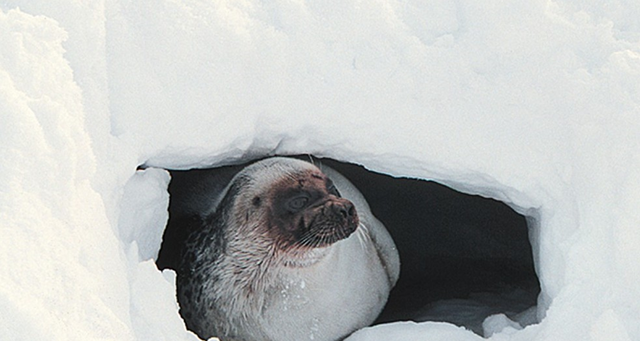

| Visitors Now: | |
| Total Visits: | |
| Total Stories: |

| Story Views | |
| Now: | |
| Last Hour: | |
| Last 24 Hours: | |
| Total: | |
U.S. lists 2 ice seal species as threatened, including ringed seals, which are prey of polar bears
ANCHORAGE, Alaska, 21 December 2012 (AP) – Two types of ice seals joined polar bears Friday on the list of species threatened by the loss of sea ice, which scientists say reached record low levels this year due to climate warming.
Ringed seals, the main prey of polar bears, and bearded seals in the Arctic Ocean will be listed as threatened under the Endangered Species Act, the National Oceanic and Atmospheric Administration announced.
A species is threatened if it’s likely to become endangered within the foreseeable future throughout a significant portion of its range.
The listing of the seals came after federal scientists did an extensive review of scientific and commercial data. It has no effect on subsistence hunting by Alaska Natives.
“They concluded that a significant decrease in sea ice is probable later this century, and that these changes will likely cause these seal populations to decline,” said Jon Kurland, protected resources director for NOAA Fisheries’ Alaska region.
Alaska Gov. Sean Parnell late Friday called the science behind the decision speculative and said the state will consider legal action. The state unsuccessfully challenged the polar bear listing.
The ringed seal population is in the millions and the bearded seal population is in the hundreds of thousands, Parnell said in a prepared statement. Neither is in decline nor will it be by mid-century, he said.
“The ESA was not enacted to protect healthy animal populations,” Parnell said. “Despite this fact, the NMFS continues the federal government’s misguided policy to list healthy species based mostly on speculated impacts from future climate change, adding additional regulatory burdens and costs upon the State of Alaska and its communities.”
Ringed seals are the only seals that thrive in completely ice-covered Arctic waters. They use stout claws to dig and maintain breathing holes.
When snow covers those holes, females excavate and make snow caves, where they give birth to pups that cannot survive in ice-cold water and are susceptible to freezing until they grow a blubber layer.
A species is threatened if it’s likely to become endangered within the foreseeable future throughout a significant portion of its range.
The listing of the seals came after federal scientists did an extensive review of scientific and commercial data. It has no effect on subsistence hunting by Alaska Natives.
“They concluded that a significant decrease in sea ice is probable later this century, and that these changes will likely cause these seal populations to decline,” said Jon Kurland, protected resources director for NOAA Fisheries’ Alaska region.
Alaska Gov. Sean Parnell late Friday called the science behind the decision speculative and said the state will consider legal action. The state unsuccessfully challenged the polar bear listing.
The ringed seal population is in the millions and the bearded seal population is in the hundreds of thousands, Parnell said in a prepared statement. Neither is in decline nor will it be by mid-century, he said.
“The ESA was not enacted to protect healthy animal populations,” Parnell said. “Despite this fact, the NMFS continues the federal government’s misguided policy to list healthy species based mostly on speculated impacts from future climate change, adding additional regulatory burdens and costs upon the State of Alaska and its communities.”
Ringed seals are the only seals that thrive in completely ice-covered Arctic waters. They use stout claws to dig and maintain breathing holes.
When snow covers those holes, females excavate and make snow caves, where they give birth to pups that cannot survive in ice-cold water and are susceptible to freezing until they grow a blubber layer. […]
Feds list 2 ice seals as threatened, including ringed seals, which are prey of polar bears
2012-12-24 09:30:27
Source: http://www.desdemonadespair.net/2012/12/us-lists-2-ice-seal-species-as.html
Source:



